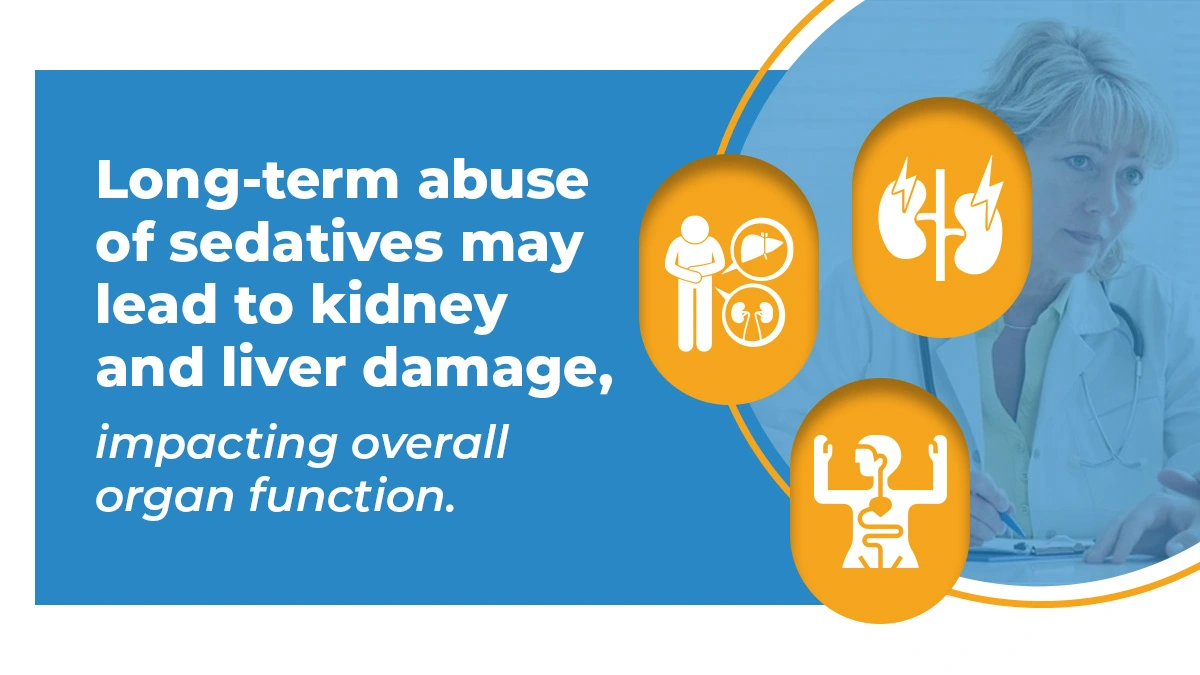Sedative Addiction: Risks and Recovery Paths
Sedative addiction emerges when individuals misuse medications meant to induce calmness, like benzodiazepines or sleep aids. Regular use beyond prescribed limits alters brain chemistry, fostering dependence in the body.
Treating addiction involves a comprehensive approach. Professional supervision is crucial to manage these effects safely. Therapy, like cognitive behavioral therapy (CBT), helps address underlying issues driving addiction.
Understanding addiction’s nature is the first step toward effective intervention. In this article, we will learn the immediate and long-term effects of sedative abuse, the risk of overdose, how to identify addiction, and the consequences on physical, emotional, and social health.
Key Takeaways
The abuse of sedatives can cause serious harm to both physical and mental health. Here’s what you need to know:
- The risk of overdose is a critical concern associated with sedative abuse.
- Long-term abuse may lead to liver and kidney damage, impacting overall organ function.
- The environment in which a person lives also influences the likelihood of sedative addiction.
- Seeking professional help contributes to a successful recovery journey.
The Recovery Team is an experienced facility that guides individuals on their journey to overcome sedative addiction with personalized care and support. Call us at (800) 817-1247 to explore our services.
Dangers of Sedative Abuse
Sedative abuse poses significant risks to physical and mental well-being. While these medications are intended for therapeutic purposes, sedative abuse can lead to immediate and long-term consequences.
Immediate Effects of Sedatives
The immediate effects of sedatives can be deceivingly calming, leading individuals to believe they provide a quick solution to stress or insomnia. Sedatives act on the central nervous system, inducing feelings of relaxation and drowsiness.
However, misuse can impair coordination, cause slurred speech, and cause dizziness. Such effects increase the risk of accidents, falls, and injuries.
Long-Term Effects of Sedatives
Continued sedative abuse can lead to severe long-term consequences. Persistent use may result in tolerance, where higher doses are needed to achieve the same calming effect.
This escalation often leads to physical and psychological dependence, making it challenging for individuals to function without the drug. Long-term sedative abuse has been linked to memory impairment, cognitive decline, and decreased overall mental sharpness.
Risk of Overdose
The risk of overdose is a critical concern associated with sedative abuse. Overdosing on sedatives can cause respiratory depression, leading to difficulty breathing or, in extreme cases, respiratory failure.
Combining sedatives with other substances, such as alcohol or opioids, significantly increases the likelihood of a life-threatening overdose. Recognizing the signs of overdose, including slowed breathing and loss of consciousness, is crucial for seeking immediate medical attention.
Causes of Sedative Addiction
Sedative addiction is a complex issue influenced by various factors. Genetic predisposition, environmental circumstances, and co-occurring mental health disorders contribute to the development of dependence.
Genetic Factors
Genetics plays a role in an individual’s susceptibility to addiction. Some people may be genetically predisposed to substance dependence, making them more vulnerable to the addictive properties of sedatives. Understanding one’s family history can shed light on potential genetic factors leading to the risk of sedative addiction.
Environmental Factors
The environment in which a person lives also influences the likelihood of sedative addiction. Stressful life events, trauma, and exposure to substance abuse within the family or community can contribute to the development of addictive behaviors. Creating a supportive and healthy atmosphere is essential in preventing and addressing sedative addiction.
Co-Occurring Mental Health Disorders
Individuals with co-occurring mental health disorders (anxiety or depression) may be at a higher risk of sedative addiction. Seeking relief from emotional distress, they may turn to sedatives to self-medicate. Treating underlying mental health issues through therapy and appropriate medications is vital for breaking the cycle of sedative abuse.
Identifying Sedative Addiction
Recognizing sedative addiction involves understanding the signs and symptoms associated with misuse. Common indicators include a preoccupation with obtaining and using sedatives, neglecting responsibilities, and unsuccessful attempts to cut down or quit.
Physical symptoms may include changes in sleep patterns, weight loss, and a drop in personal hygiene. If someone exhibits these signs, seeking professional help is imperative for early intervention.
Cycle of Sedative Addiction
The cycle of sedative addiction is a relentless pattern that snares individuals in a web of dependence. Starting with initial use and abuse, escalating into addiction, and perpetuated by withdrawal and dependence, this cycle traps its victims.
Initial Use and Abuse
The cycle of sedative addiction often begins with the initial use of the medication. Whether prescribed for anxiety, insomnia, or other conditions, individuals may find the calming effects appealing. However, abuse, such as taking higher doses than prescribed or using the medication recreationally, can lead to the development of addictive patterns.
Escalation and Addiction
As tolerance builds, individuals may escalate their use of sedatives to maintain the desired effects. This escalation can quickly lead to addiction, where the compulsion to use sedatives overrides the ability to control consumption. The brain adjusts to the existence of the drug, reinforcing the cycle of dependence and making it increasingly challenging to quit.
Withdrawal and Dependence
Attempting to quit sedatives can trigger withdrawal symptoms, reinforcing dependence on the substance. Withdrawal symptoms may include heightened anxiety, insomnia, nausea, and irritability. The fear of experiencing these uncomfortable symptoms drives individuals to continue using sedatives, perpetuating the cycle of addiction.
Consequences of Sedative Addiction
Sedative addiction takes a profound toll on individuals, impacting physical, emotional, and social well-being. The consequences extend beyond immediate health risks, seeping into daily life, relationships, and overall quality of life.
Physical Health
Sedative addiction takes a toll on physical health, with potential consequences ranging from respiratory issues to cardiovascular problems. Long-term abuse may lead to liver and kidney damage, impacting overall organ function. Additionally, sedative abuse can weaken the immune system, making individuals more susceptible to illnesses.
Emotional Health
The impact of sedative addiction on emotional health is profound. Individuals may experience heightened anxiety, depression, and mood swings. The initial relief provided by sedatives is replaced by emotional turmoil, exacerbating pre-existing mental health issues and creating new challenges in emotional well-being.
Social Health
Sedative addiction can strain relationships and hinder social functioning. Individuals may withdraw from family and friends, prioritizing drug use over personal connections.
Occupational and academic performance may drop, leading to financial instability and a compromised social support system. Rebuilding social health requires a multifaceted approach, including therapy, support groups, and rebuilding trust within relationships.
Treatment for Sedative Addiction
Seeking professional help, utilizing detoxification, engaging in therapy, and committing to rehabilitation collectively contribute to a successful recovery journey for individuals grappling with sedative addiction. This integrated treatment framework aims to address the physical, emotional, and social dimensions of sedative addiction.
Detox
Detoxification is the initial phase of sedative addiction treatment. Under medical supervision, individuals gradually eliminate sedatives from their system. This process helps manage withdrawal symptoms safely, ensuring a more comfortable transition to the following stages of recovery. Detox alone is insufficient for long-term success but is a critical first step.
Therapy
Therapy plays an integral role in managing the root causes of sedative addiction. Cognitive behavioral therapy (CBT) helps individuals recognize and change negative thought behaviors associated with drug use. Counseling sessions provide a supportive environment to explore underlying issues, develop coping mechanisms, and foster a mindset conducive to recovery.
Rehabilitation
Rehabilitation, or rehab, is the comprehensive phase of treatment where individuals engage in structured programs addressing physical, emotional, and social aspects of addiction. Inpatient or outpatient options offer varying levels of support. Rehab includes individual and group therapy sessions, educational programs, and relapse prevention strategies, fostering a holistic approach to recovery.
Address Addiction With The Recovery Team
The Recovery Team is a shelter for individuals overcoming addiction challenges, whether sedatives or any other substance.
Our tailored residential program offers compassionate care, counseling, and a structured routine to pave the way for lasting recovery. A supported reintegration through our transitional living ensures a seamless transition.
Our dual diagnosis approach addresses both addiction and underlying mental health, while personalized therapy unveils triggers, builds coping strategies, and fosters resilience.
Start living a life rich in possibilities. Call (800) 817-1247 for more information and to begin your path to recovery.






